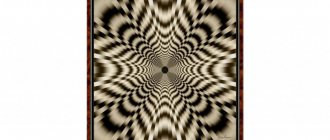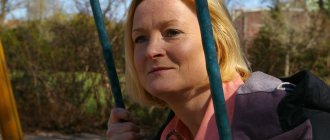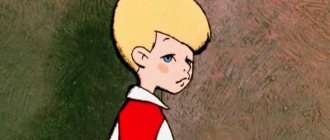What did ancient philosophers say about her?
Scientists of the ancient East and West approached the study of what human activity is from both materialistic and idealistic points of view.
You may be interested in: Formation and development of general educational skills in schoolchildren
Socrates (470-399 BC, Ancient Greece) explained it by the state of the soul, which he considered its mental property, the focus of moral ideas. These ideas are formed as a result of a person’s learning what is good and evil, and the types of activity and the nature of his actions depend precisely on this knowledge. Socrates' slogan “know thyself” should be understood as a call to analyze behavior and attitudes towards it, and not to analyze one’s own emotions and experiences.
Aristotle (384-322 BC), studying what mental activity is, called exercise in moral actions as a condition for its increase. Simple knowledge of good and evil does not make a person the owner of such qualities as, for example, virtue and prudence - constant training and exercise in them make him such.
Channel PROGRAMMER'S DIARY
The life of a programmer and interesting reviews of everything. Subscribe so you don't miss new videos.
The teaching of the Stoics arose in Athens in the 4th century BC. e. His followers believed that increasing the activity of the psyche is inaccessible to ordinary people, its guidance is the lot of only true sages, whose mind is dispassionate and does not allow emotional experiences. Any emotional upheaval deprives a person of internal freedom and interferes with the fulfillment of his duty.
Epicurus (341-270 BC, Ancient Greece), on the contrary, considered renunciation of social activity to be true happiness. He saw it in the satisfaction of simple needs. The will, mind, and mental activity of a person must be directed to training in self-restraint from unattainable pleasures, otherwise suffering from their unattainability is inevitable.
Types and forms
The concepts of types and forms of social activity are not synonymous.
The type indicates the nature of the relationship between a person and the object of activity, and the form specifies this nature, taking into account the method of achieving the goals.
As a rule, there are six main types of social activity:
- material-transformative , aimed at creating objects of labor as necessary benefits of the material world,
- scientific-cognitive , consists of conducting research and experiments, creating concepts, theories and models, developing and specifying means or methods of work and knowledge,
- artistic and aesthetic , satisfies the spiritual needs of both the subject of the activity and other people,
- value , leads to changes in the existing system of moral, social, political and other values,
- communicative , reflected in the interaction of a person with individuals and society, the exchange of culture and worldviews, the modernization of society,
- healthcare , aimed at preserving and maintaining the life and health of people.
If the boundaries between types of social activity are strictly defined, then its forms have neither an exact number nor clearly expressed external restrictions.
This or that form becomes a derivative of the experience of generations and has specific features determined by the conditions of its formation in each specific social group. The most typical forms of social activity are:
- Cognitive and labor. Reflects a person’s readiness and ability to accumulate professional knowledge in his field of activity, improve skills and abilities to carry out material-transformative or scientific-cognitive activities. This form of social activity satisfies not only material needs, but also the need for self-actualization.
- Self-educational and self-educating. They serve as a projection of personal motivation in satisfying intellectual needs. Often, the incentive for such activity is a person’s involvement in social life, his interaction with society.
- Contact .
It is explained by a person’s desire to belong to a certain social group, to communicate and interact with others. It is decisive in areas of activity based on a team approach to solving problems and achieving set goals. The contact form of activity develops a person’s communication skills, stimulates cognitive and labor activity, self-education and self-education. - Educational and educational. Satisfies the individual’s need for information or his desire to share acquired knowledge and experience with others. Includes a complex system of communicative interactions, including educational institutions, libraries and databases, and the media.
- Socio-cultural. It has much in common with the contact form of activity, but takes into account another criterion for the formation of social groups, cultural and historical. Such activity is built on an array of moral values, norms of behavior, laws and rules. A striking example of socio-cultural activity is youth subcultures.
- Social and organizational. It is based on a community of interests and needs, and in a more global sense, a community of origin, territorial and cultural proximity of people. The most significant component of social and organizational activity is civic activity, which is a way of self-realization of an individual as a full member of civil society, a participant in political and social life, having his own worldview and defending certain social institutions.
In an ideal society, each individual harmoniously combines all forms of social activity, contributing not only to personal development, but also to the development of society as a whole.
In practice, such a situation is rarely encountered ; most often a person concentrates on one or several forms, and the rest are developed only to the extent sufficient to realize the main goal of social activity.
Does society need active people?
Stimulating employee business entrepreneurship is one of the goals of modern management. Its development leads to a significant increase in labor productivity and the development of a culture of industrial and non-productive relations.
You may be interested in:What is litmus and how is it useful?
In psychology, activity is defined as the activity of an individual aimed at the environment in order to satisfy his own needs. Its owner is considered to be a person with such personal qualities as:
- focus,
- awareness of the choice of ways and means to achieve goals,
- the ability to analyze the results of one’s actions and adjust them taking into account the current situation.
Such an individual, satisfying his own material, social, ethical, artistic needs, strives to transform the environment, meaningfully improves tools, and participates in solving creative labor and social problems. His personality improves because he wants to know more, learn a lot. That is, it can be argued with good reason that the initiative of members of society contributes to its comprehensive progress.
Activity Active
Life gives us what we are ready to realize or consciously try to get from it, and not what fits only into our rosy dreams and empirical desires. What you count on, what you achieve with deeds and not with words, that’s what you will find. The active practitioner receives victories, the inactive dreamer receives disappointments.
Tatiana Ustimenko. A Prince for a Crazy Princess.
Activity as a personality quality is the ability to maintain an active state of body, mind, mind and soul, readiness for change, a tendency to actively use one’s time, to be easy-going, to make efforts independently, and not to be led by circumstances.
One day, the king decided to put all his courtiers to the test in order to find out which of them was capable of occupying an important government post in his kingdom. A crowd of strong and wise men surrounded him. “Oh, you, my subjects,” the king addressed them, “I have a difficult task for you, and I would like to know who can solve it.” He led those present to a huge door lock, such a huge one that no one had ever seen. - This is the largest and heaviest castle that has ever been in my kingdom. Which one of you can open it? - asked the king. Some courtiers only shook their heads negatively. Others, who were considered wise, began to look at the lock, but soon admitted that they could not open it. Since the wise ones had failed, the rest of the courtiers had no choice but to also admit that they were unable to do this task, that it was too difficult for them. Only one vizier approached the castle. He began to carefully examine and feel it, then tried to move it in various ways and finally pulled it with one jerk. Oh miracle! - the lock has opened! It just wasn't fully latched. Then the king announced: “You will get a place at court because you rely not only on what you see and hear, but rely on your own strength, are not afraid to try, and are active.
Optimal management requires people to be interested in being active.
Personal activity is the inclusion in the intensive work mode of such qualities as focus, motivation, awareness, professionalism, emotionality, initiative and situational awareness. The Russian language dictionary gives a commonly used definition of “active” as active, energetic, developing.
Activity means letting your talent, your life purpose, manifest itself. Active talent will bypass a passive genius, like a jeep cart “carrying a cart of brushwood.” Activity is the ability to improve oneself, give and receive love, renew oneself, systematically satisfy the needs of one’s mind, mind and soul, experience a versatile and, at the same time, deep interest in different areas of life, be purposeful, showing perseverance and perseverance on the way to the goal and consistency.
Activity in goodness breaks out of the boundaries of one’s egoism and selflessly serves people. Activity in passion is the personification of enterprise, efficiency and initiative. People, realizing material goals, strive to create new industries, organize companies, cultivate their lands, advertise and sell their products, earn more money, place their savings in banks or in shares of some enterprises. Activity in ignorance is the desire to twist someone's head, to quickly rip off money in an illegal way. It is better to disengage from such evil activity. In other words, activity is a person’s manifestation of socially significant efforts, socially recognized purposeful behavior .
Activity lives in the “here and now” mode. Activity in the past or in the future are illusions of activity, excuses for a lazy mind. For activity there is only today and now. Nolan Bushnell, the “father” of video games, one of the most successful businessmen, states: “The most important thing is to do at least something to achieve success, and do it right now. This is the most important secret - despite all its simplicity. Everyone has amazing ideas, but rarely does anyone do anything to put them into practice, right now. Not tomorrow. Not in a week. Now".
One day a student asked the Teacher: “Teacher, tell me, is there a day most favorable for making an offer to a buyer?” - Day? - the Teacher was surprised. “Well, maybe the day of the week or the day of the month...” “Ah-ah, the day of the week...” nodded the Teacher. - Yes, sure. This day is Wednesday,” and looked slyly at the students. They grabbed their notebooks and began to write down what the Teacher said. - Why don’t you write it down? - he strictly asked the student, who was sitting upright and smiling, looking at the Teacher. - Because I know what you will say next, Teacher. - And what? “The teacher, frowning, raised his hand, and all the students froze. Then the student who did not write down said: “This is also Tuesday, Friday, Saturday, Monday, Thursday and Sunday.” “You’re right,” said the Teacher. - Only I wanted to call it Friday first, and then Tuesday. The students made a noise, rejoicing that their friend said almost everything correctly. And then one of them asked: “Teacher, is this the sequence?” The teacher looked carefully at the student, who gave almost the correct answer and made a sign to him with his hand: “Answer!” “Only one day,” he said. - This day is today.
At the same time, there should be no excess or redundancy in activity. A person should not work like Papa Carlo, so that his health does not suffer, family relationships are not destroyed, and there is no time for personal growth. Chinese philosopher Chang Ying Yu states: “Anyone who is as active as a bee during the day, strong as an ox, works hard as a horse and comes home in the evening as tired as a dog should consult a veterinarian - there is a high probability that he is a donkey.”
The energy of activity is given one to the husband and wife. The ideal option is when the woman is calm and the man is active. He is responsible for the material, emotional and spiritual protection of the woman, he is in more contact with the outside world, and he “holds the cards” - to be active for the benefit of his wife and children. A twitchy, nervous woman is nonsense for a family; it is a convenient platform for stress not only for herself, but for all family members. Don't take your mother-in-law into account. She is always active and always under stress. A man's activity never creates stress.
The man knows that water does not flow under a lying stone, that he needs to work, be active, otherwise the children will ask: “Dad! Bread!”, and he will shyly look away if he has a conscience. A Persian proverb says: “The man is the one who closes his mouth and rolls up his sleeves.” One day, a certain man, walking through the forest, saw a lame fox. He was surprised by how she maintained her existence, and he decided to observe her. Soon he saw a lion emerge from the forest with a piece of meat in his teeth, eat a little and leave it to the fox. The man who watched this was quite surprised, and concluded for himself that if he behaved like this fox, then Providence would undoubtedly do the same to him. He sat down on the ground and waited. Time passed, but nothing happened over time, and the man became weaker and weaker. And so, when he was so weak that he could not get up, a voice came from heaven: “Don’t be a lame fox!” Be a strong lion, and then you can feed yourself and provide for others!
Sometimes activity in a person manifests itself under the influence of an extreme situation, when inaction is destructive, when it is necessary to act decisively and urgently. One day Bernard Shaw called his doctor and said: “I feel very bad.” My heart seems to be completely giving out. Come soon! The doctor came running. He had to run up three flights of stairs and was breathing heavily. He walked in and, without saying a word, collapsed into a chair and closed his eyes. Bernard Shaw jumped out of bed and asked in fear: “What’s wrong with you?” “Nothing, nothing,” answered the doctor. - Looks like I'm dying. Heart attack. Bernard Shaw rushed to help him: he brought a glass of water, some pills, he did everything he could. Half an hour later his doctor came to his senses. And suddenly he said: “Now it’s time for me to go, give me my fee.” - Wow! - Shaw exclaimed. - You should pay me! I ran around you for half an hour, and you didn’t even ask anything about my well-being. “I cured you,” the doctor objected to him. “This is treatment, and you will have to pay me.”
Petr Kovalev 2013 Other articles by the author: https://www.podskazki.info/karta-statej/
Activity levels
The more attractive a person’s goal is, the more energy he spends to achieve it. The highest level of activity is observed in people with a harmonious personality type: they have highly developed both responsibility for the task and the desire to obtain the greatest internal satisfaction from its results.
Individuals of the productive type also have high results of actions, however, they achieve them because of their passion for their ideas, and not because of a high level of responsibility.
The reflexive type is distinguished by heightened consciousness and hypercontrol, but these qualities, combined with self-criticism, make him unsure of himself and his initiatives. Therefore, he is ready for their active implementation only with outside moral support.
People of the performing and functional type show lack of independence in achieving the goals set for them. Having taken responsibility, they strictly follow third-party directions and instructions, use ready-made solutions, without using their own initiative.
Contemplators can put forward complex business and creative proposals, but in the foreground they put forward the promotion of their own “I”, and not the activity of implementing their ideas. Lack of responsibility and independence, aggressiveness are characteristic features of people of this type.
You might be interested in: Development of a truncated cone. Area formula and example of solving the problem
Thus, what level of activity he has (high, medium or low) depends both on the person’s natural personal qualities (temperament, abilities), and on those brought up in him by his parents and social environment.
What is an active life position, a socially active personality? There is no simple answer to this seemingly simple question. These expressions contain many different meanings. Therefore, the answers may be different - depending on the position, field of activity, and experience of the person answering.
Our first interlocutor was a teacher from one of the Cherepovets schools with twenty years of teaching experience (at the request of our interlocutor, we will not mention his name).
— An active life position is something that everyone talks about, but that is difficult to formulate. We would like this to always be a positive activity that takes the form of collectivism, camaraderie, the ability to make friends and be loyal to your friends. Maybe such social activity is simply kindness, compassion, humanity. This means that we must collectively instill this in our children.
But talking about kindness and humanity within the school curriculum is not so easy. After all, as a rule, practically the only traditional school course where issues of morality and humanism are discussed directly and in a systematic manner is the literature course. But this is precisely what education reformers are trying to deal with all the time, either trying to reduce everything or simplify it...
You also need to take into account the context: television and the Internet, computer games and social networks. They are wonderful and useful in themselves. But we can’t seriously say that it is computer “shooters” and “adventure games” that instill humanity? The world around us appears tough, sometimes cruel. Does such a world prepare a teenager for the real difficulties of life? Huge question. Therefore, we need joint efforts to humanize our education, to strengthen the role and place of those few humanitarian subjects that can provide models of behavior or, at least, make us think about the eternal questions of good and evil, responsibility and love.
A person who perceives the world through the prism of these issues is a socially active person, a sympathetic and empathetic person.
What's next? For most of today's graduates, outside the school walls are university classrooms. The student is a special category, the most active in public opinion. Is this so, we ask our next interlocutor, Director of the Humanities Institute of ChSU, Professor Alexander Chernov.
— I’ll try to narrow down the problem. We are probably not interested in youthful physiology, which gives rise to many activities, including social ones... In general, there is nothing to say about it. Except, perhaps, for one thing: there is the opinion of sociologists, according to which we live in an era when childhood is disappearing again... Until the 18th century, there was no childhood as such, and there was no child, there was a small adult, who was treated differently in different cultures and different faiths. differently. And childhood was invented by educators.
Today, childhood is disappearing in the other direction - it does not want to stop, and social infantilism is developing, on the one hand, and entire subcultures, like adults, who consciously do not want to grow up, are developing on the other.
There is an important factor. The entire modern global industry of meanings and signs is aimed at combating age. Consumer culture needs active consumers with the insatiability of youth and older people with thick wallets and plastic cards.
The university is a special place where the most current trends and emerging tendencies intertwine. Why about adulthood and childhood? Because, in my opinion, an active life position has only one reliable basis - independence and independence. Independence is always responsibility. Willingness to take risks and refuse excessive care. Passionate about creativity, hobbies, their first business, love, freedom and lack of school parental control, a sense of adulthood, finally, are the guys ready to deal with the fact that they, to use slang, “messed up”?
The good news is that there are more and more of those who are ready. And the result obtained on the state exam does not result in a “lost year,” but a successful career in a retail chain and successful passing of the state exam a year later. Or passion for a profession forces you to start and quit programs and specialties one after another. But after three or four “re-entries,” the talented guy managed to be internally disciplined and successfully combine study and work. This is an example of positive life activity: responsibility for oneself, one’s destiny.
And that means real adulthood. Young people should have the right to make some mistakes, to make independent decisions, to make their own free choice. It's their right, and that's okay. Can this be taught? Hardly. But in my opinion, the education system is simply obliged to promote the formation of social norms, prepare and help.
What do professional sociologists think about the problem of social activity? For the answer, we turn to an authoritative researcher of social problems of the region, head of the department of sociology and social technologies of the Humanitarian Institute of ChSU Albina Mekhova .
— An active life position means a caring attitude to what is happening around. That is, not just acceptance, but also active participation in solving those problems that arise not only in oneself, but in society, in the world around us. It all starts with family. But society, as a macroenvironment, must also form an active life position or influence its formation. That is, exactly those actions that can be designated as an active life position should be stimulated and encouraged: take initiative, not remain silent, and not pass by socially dangerous cases indifferently.
Nowadays, an individual lifestyle is encouraged. But this individuality, this inner world must be directed towards the correction of society. Fundamental changes are needed: the inclusion of young people in solving pressing issues, not only their own, but such as communal problems, educational problems, that is, we are talking about how they live, what they are involved in.
I would also like to note one thing: the school should play a big role in this issue, not only from the point of view of knowledge, but also from the point of view of creating an environment where the child sees examples of caring.
What conclusion do we arrive at? Social activity and an active life position are a sign of growing up. But for them to form and develop, conditions are needed, the position of society is needed... The search for a young man must meet with understanding. Naturally, if he is not dangerous to others. It's great when there are many options for self-realization. The difficulty is that this formation takes place in real life, among real people. But there’s nothing you can do about it: you can’t learn to swim on the shore.
Alexander Valentinov
Forms and factors of human activity
At birth, a person is completely dependent on the people around him. But as he grows up and develops, new opportunities appear that support his independent existence as an individual and encourage him to engage in certain types of activities.
Soviet psychologist B. G. Ananyev, in his research, identified such forms of human activity as communication, work and cognition.
In the works of other scientists, these include contemplation, reflection and behavior, managing other people, amateur performances, as well as creative, artistic, cognitive, incentive, practical, combat, sports, information and communication forms.
The reasons or factors of human activity are explained by the need to satisfy a number of needs that guarantee him, firstly, physical survival (food, clothing, housing, protection, reproduction). Secondly, he needs communication and recognition by other members of society, which is a source of intensification of his labor and communication activities. Thirdly, satisfying spiritual needs requires the individual to have his own energetic search for inner freedom, self-promotion in creativity, and actions to change the environment in accordance with his views and needs.
Structure and components
Independent sources provide a variety of theories about the structure of social activity, but they all agree on one thing: this structure is based on two fundamental criteria : practical and spiritual.
They complement and stimulate each other and determine the components of any human activity. As a rule, the role of these components is played by :
- Motive . The primary motive for any activity of living beings is the preservation, maintenance and reproduction of life. With the development of human thinking and self-awareness, deeper motives, self-expression, self-realization, and social significance appeared.
- Target . It represents a specific image, a mental model of the desired result, towards which human activity is aimed. Based on the significance of specific actions and deeds for society, goals are conventionally divided into constructive and destructive; the role of their qualitative indicator is played by the so-called value meaning.
- Productivity . Takes into account all the means used by a person to achieve a goal. The productivity stage ends with a result that may or may not meet the goal. In the second case, activity often takes on a cyclical nature.
It is noteworthy that these components of activity were formed at the dawn of civilization; in many ways, they became the catalyst for the processes of creation and development of society.
All social transformations that have taken place in human history are based on motives, goals and productivity.
Activity as a result of education
In order to act purposefully, a person must show creativity, strong-willed efforts, communicate with other people - seek advice, study other people’s experiences. But these qualities - a strong will, a non-standard approach to a problem, the ability to communicate, analyze, draw conclusions - are not born with the baby. What is activity? This is the result of proper upbringing.
Its formation in a child is one of the many parental tasks, which is not as simple as it seems at first glance. First of all, adults are required to have a conscious approach to achieving this goal and patience: the development of activity is one of those pedagogical problems that cannot be solved quickly.
Note to parents: how to do this
An active person means active, energetic. Children become like this in families that support a democratic style of relations between them and adults. It presupposes flexibility in relationships: by showing sufficient demands and control, parents respect the child’s opinion and position, develop his independence, initiative, and self-criticism. Possible instructions and meaningful encouragement stimulate increased activity in achieving the goal. What is important is sufficient help, a calm, business-like analysis of both the results of the child’s initiative, as well as mistakes made and successful actions.
An authoritarian parenting style suppresses a child’s activity, since threats of punishment and coercion cause fear of violating an adult’s instructions and making mistakes in their actions.
The liberal style, on the contrary, is undemanding towards children. Maximum freedom with a minimum of restrictions on behavior creates aggressiveness and permissiveness. Such children believe that achieving a goal consists of forcing adults to bring them what they want on a platter, and not in showing intelligence and enterprise themselves.
Society as a subject of education of activity
The state is extremely interested in educating active and proactive citizens. That is why any educational institution, the media, among other tasks, set themselves the difficult task of creating activity among the population.
Teachers, psychologists, social workers, cultural workers, public associations, leaders of all ranks act as subjects of the process, the goal of which is to educate a socially responsible citizen. He must have:
- interest in social work,
- organizational qualities,
- diligence and initiative,
- self-criticism and demandingness towards oneself and others,
- willingness to help people.
These qualities guarantee the provision of public order and control over the implementation of laws at the local level, and direct interaction between the population and the authorities.
“Formation of a socially active personality of a teenager”
“Formation of a socially active personality of a teenager”
The formation of a socially active personality is a complex, contradictory process. The first questions that arose at the beginning of the study: what is a socially active person? Norm (model) of a socially active personality
- this is the ability of an individual in his development to acquire the social essence of a person who has the following characteristics: attitude towards another person as an intrinsic value; ability for dedication; creative nature of life; the ability to express free will; the ability to design your future: internal responsibility to yourself, other people, the past and the future; the desire to find meaning in life. “Socialization is the process of an individual’s assimilation of social experience, a system of social connections and relationships,” this definition is given by a psychological dictionary and adds: “In the process of socialization, a person acquires beliefs, socially approved forms of behavior, necessary for him to live a normal life in society.”1 In the process of socialization, a teenager acquires social experience of activity, which includes:
- value experience: moral norms, values;
- operational experience: general labor skills, self-regulation skills, development of psychological processes (memory, thinking, imagination, etc.), realistic life plans;
- experience of primary activation: operational adaptability to stable and unstable conditions, social resistance to negative influences, adequate level of achievements;
- experience of relationships and cooperation: communication knowledge, skills, ability to resolve conflicts, work in a team, be motivated:
- experience of reflection - the ability for introspection, decision-making, the ability to make choices and take responsibility for one’s actions.
Thus, in the process of socialization, a person not only enriches himself with experience, but also realizes himself and self-determines. However, we meet people who are completely socialized, who have actually dissolved in society, but who are not ready and incapable of the activity that is needed to resist the environment, influence it, and possibly more fully realize themselves in the process of socialization.” I reflected the components of social and pedagogical activity in the following tasks
their implementation:
social learning, social education, social and pedagogical support.
Education is social
active
personality of the younger generation.
The task of the class teacher is to pay attention to the smallest features of the student’s personality and treat its manifestations with respect, even when these manifestations do not meet
teacher's expectations. It is necessary to convince the student of the value, usefulness and necessity of manifestations of his individuality. What real conditions did I create to promote the development of social media? active personality.
The transformations taking place in Russian society put forward high demands on the level of social activity of the individual. The increasing degree of dynamism and variability of the surrounding society puts the task of actively including the individual in transformative interaction with the environment among the most pressing tasks of the social formation of a subject of public life.
For modern pedagogical science, the problem of forming the social activity of the younger generation is particularly significant and is invariably in the center of attention of society and the state. It is social activity that is one of the most important qualities of a person, which is formed in activities that are distinguished by socially significant motives and produce a socially valuable result.
A.V. Petrovsky, a Russian psychologist, specialist in the history of psychology, social psychology and personality psychology, defines social activity as a person’s active life position, expressed in his ideological adherence to principles, consistency in defending his views, unity of word and deed.
In pedagogical science, the concept of social activity of an individual has undergone changes in recent years. Thus, professor, candidate of pedagogical sciences N.V. Savin at one time defined social activity as socio-political activity, which is a complex moral and volitional quality that organically combines interest in social work, responsibility in carrying out assignments, diligence and initiative, demandingness towards oneself and comrades, readiness to help others when carrying out public assignments, having organizational skills.
I.F. Kharlamov, Doctor of Pedagogical Sciences, Professor, Honored Member of the Russian Academy of Education, defines the development of a student’s social activity as a process of purposeful influence on him, as a result of which he acquires the social experience necessary for life in society and an active attitude towards the value system accepted by society, and forms a stable a system of relationships to certain aspects of reality, manifested in corresponding behavior and actions. The latest definition of social activity is more complete and meets the requirements of today.
Currently, the problem of forming the social activity of adolescents in the process of artistic and aesthetic activity is determined by society’s need for a socially active individual and the insufficient involvement of young people in socially significant activities, including artistic and aesthetic activities.
The state youth policy of Khanty-Mansi Autonomous Okrug-Yugra as a branch of social policy as a whole was formed not so long ago. Ugra is one of the few subjects of the Russian Federation where institutions of additional education, participating in various specialized programs and projects, actively include youth in the social environment, thereby developing their communication skills, gaining communication experience, and determining their place and functions in the structure of society. By getting involved in the activities of additional education institutions, adolescents acquire new value guidelines and set priorities. However, the problem of forming the social activity of adolescents as a special age category has not been sufficiently studied. At the same time, the knowledge of the theoretical foundations of the category “social activity” and the characteristics of raising adolescents, as well as the presence of practical experience in the formation of social activity of adolescents in an additional education institution, create the basis for conducting a holistic study in this subject area.
Thus, a number of problems can be identified:
- between the need to develop an individual’s readiness for active inclusion in transformative interaction with the environment and insufficient attention to the problem of purposeful formation of social activity of adolescents in institutions of additional education for children;
- between the elaboration of the essence of the category “social activity” and the lack of comprehensive research on the problem of the formation of social activity of adolescents;
- between the presence of original experience in organizing the education of social activity of adolescents and its insufficient scientific and methodological understanding.
Artistic and aesthetic activity as an organized pedagogical process provides great opportunities for the manifestation of qualitative and dynamic characteristics of the social activity of adolescents and is a factor in its formation. Meanwhile, the teenager is practically unfamiliar with such activities, which reduces not only his social activity, but also the level of general culture as a whole.
All of the above indicates that the organization of socially significant artistic and aesthetic activities of adolescents will contribute to the formation of social activity, spiritual and moral qualities, maximum disclosure of creative abilities, creation of an atmosphere of belonging, responsibility for the fate of the country and region.
Artistic and aesthetic activity as a factor in the formation of social activity of adolescents is a complex multifunctional socially significant activity for the development and dissemination of the cultural heritage of the past.
The complex of pedagogical conditions for the formation of social activity of adolescents includes:
- taking into account the severity of a teenager’s activity in socially significant activities;
- orientation of the educational process of the institution not only towards artistic and aesthetic values, but also towards other socially significant values;
- preparing a teacher for organizing the activities of teenagers;
- systematization of materials;
- development of technological support for the artistic and aesthetic activities of adolescents in order to form social activity.
The model for the formation of social activity of adolescents is a systemic education that determines the sequence and interconnection of stages, pedagogical conditions, forms and methods of organization, as well as the results of the activities of adolescents aimed at the formation of their social activity and the manifestation of the qualities of social activity - organization, independence, initiative and responsibility, in other types of socially significant activities: educational, social and leisure.
The formation of social activity consists in the search for new types of activities that contribute to the formation of social activity of the personality of adolescents, new forms of organizing the artistic and aesthetic activities of young people of different ages in order to form social activity; development of new technologies and creation of pedagogical conditions for introducing teenagers to socially significant activities.
Activities associated with creativity are creative in nature; they are free, creative activities of a teenager. In this case, a big role belongs to the teacher teaching this or that subject, i.e. depends on the methods he uses.
Activity with a minus sign
Criminal, immoral activities of citizens are not approved by society and are even punishable. What kind of activity a person has, what types, levels and forms he chooses depends on the internal position of the individual. By the actions and how it manifests itself, one can judge many human qualities. The higher the moral values, the more the ways of satisfying needs (“I want” and “I must”) correspond with the rules and norms of human existence (“It is possible” or “It is not possible”). Hence the numerous examples of selfless courage and unparalleled meanness, hard work and shameless theft of other people’s property for the sake of one’s own comfortable existence, uncompromising honesty and large-scale lies in order to become famous.
You will be interested in: Research technology: concept, introduction of new things, project development, goals and objectives
Antisocial “activity” in the selfish satisfaction of one’s needs is the result of a combination of many circumstances in a person’s personal and public life with his negative internal qualities - greed, vindictiveness, laziness, inability to control one’s actions and emotions.









